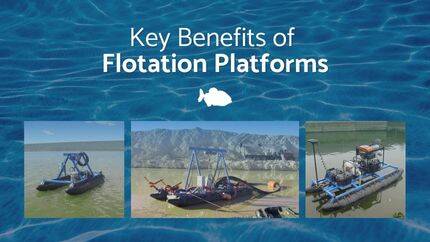Why Flotation Platforms Matter in Wastewater Dredging
Wastewater dredging plays a crucial role in maintaining efficient sewage treatment systems by removing sludge and accumulated debris from lagoons, retention ponds, and treatment basins. A flotation platform is a vital component of these operations, providing stability, safety, and efficiency for wastewater dredges. Investing in a well-designed pump barge or sewage dredge ensures effective sludge removal, helping industries maintain compliance with environmental regulations.
Key Benefits of Flotation Platforms in Wastewater Dredging
1. Enhanced Stability and Safety
A flotation platform provides a steady base for dredging equipment, minimizing risks associated with unstable ground conditions in wastewater treatment facilities. These platforms allow operators to work efficiently while ensuring their safety.
2. Increased Efficiency in Waste Removal
By supporting wastewater dredge systems, flotation platforms improve sediment removal, allowing for continuous dredging without frequent repositioning. This results in a more effective and time-efficient dredging process.
3. Adaptability for Various Wastewater Applications
Flotation platforms are designed to support different types of sewage dredges, from mechanical to hydraulic dredging systems. This adaptability ensures that industries can choose the most suitable dredging equipment for their specific wastewater treatment needs.
4. Durability and Long-Term Cost Savings
A high-quality pump barge or flotation system is built to withstand harsh wastewater conditions, reducing maintenance costs and prolonging the lifespan of dredging equipment. Investing in a durable system ensures long-term operational savings.
Key Design Considerations When Selecting a Flotation Platform
1. Load Capacity & Buoyancy
Ensure the flotation platform can support the weight of the sewage dredge and associated equipment without compromising stability.
2. Material & Corrosion Resistance
Wastewater environments contain corrosive elements, so selecting materials resistant to rust and chemical damage is crucial for longevity.
3. Modularity & Mobility
Opt for a modular pump barge system that can be easily transported and assembled to suit different dredging locations.
4. Anchoring & Mooring Systems
A secure anchoring system is essential to keep the flotation platform steady, preventing movement that could disrupt dredging operations.
Choosing the Right Wastewater Dredging Equipment
Industries must assess their specific wastewater treatment needs when selecting a wastewater dredge. Key factors include:
- Depth of Sediment: Some sewage dredges are better suited for deeper sludge removal.
- Type of Wastewater Facility: Treatment lagoons, ponds, and basins may require different dredging approaches.
- Automation Needs: Some facilities benefit from remotely operated or automated dredging systems.
A well-designed flotation platform is essential for ensuring stability, safety, and efficiency in wastewater dredging. Whether using a pump barge or a specialized sewage dredge, industries must carefully consider their dredging requirements to optimize wastewater treatment processes. Investing in the right equipment improves sludge removal, enhances environmental compliance, and maximizes cost efficiency.
Learn More
Ready to upgrade your wastewater management operations? Contact Us today for a consultation.
 PIRANHA
PIRANHA
